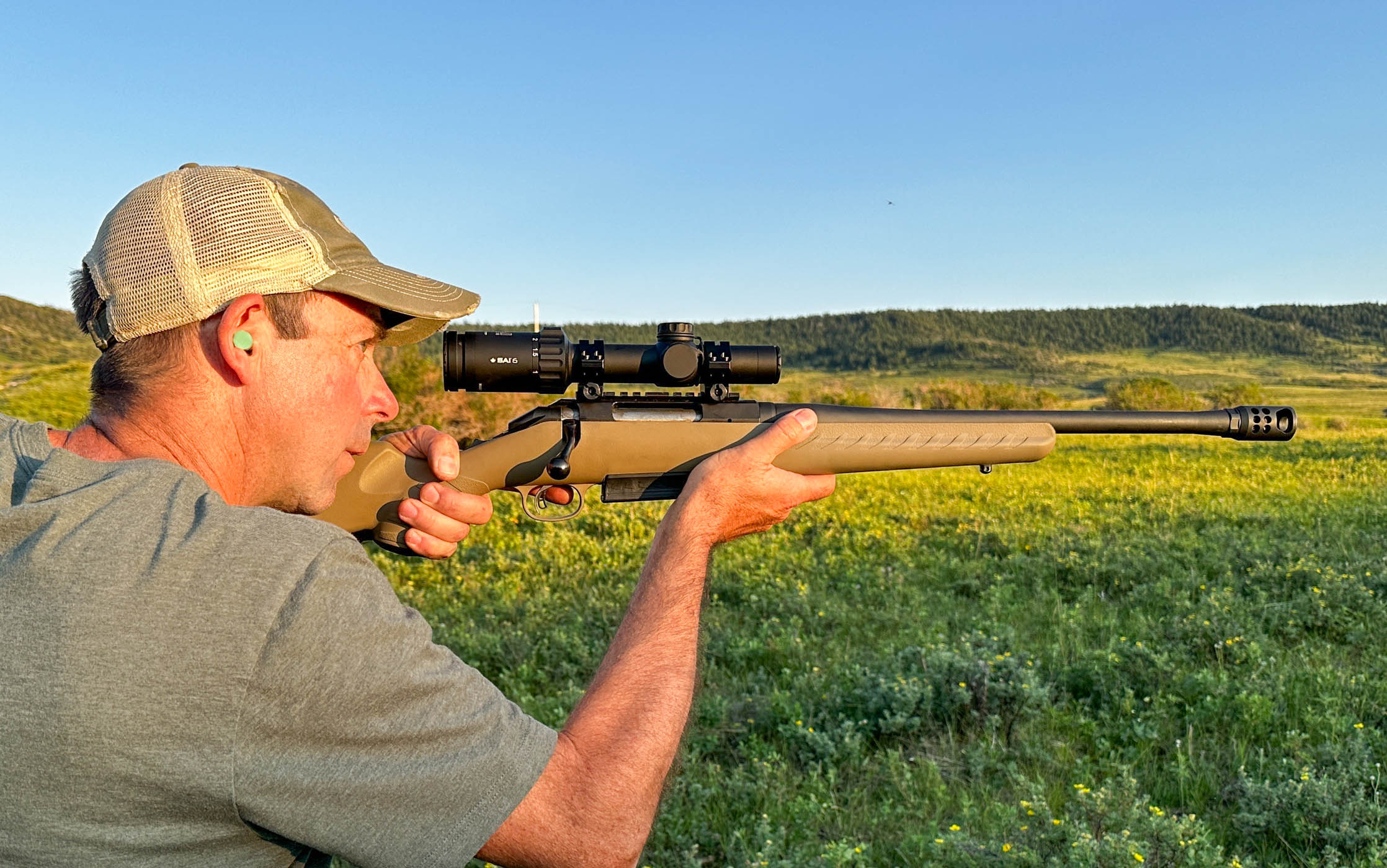We may earn revenue from the products available on this page and participate in affiliate programs. Learn More ›
Just when I thought the trend of short, fast, illuminated rifle scopes was cooling, a new class of excellent low-power variable optics revived my affection for these do-everything scopes. The new models we tested this year that can transition between ARs, turkey shotguns, dangerous-game rifles, and straight-wall carbines.
We have a full dozen of the best LPVOs in this year’s test, ranging in price from $129 to $2,150 and bringing everything to the shooting match from throwback duplex reticles to MRAD-informed segmented circles. And illumination, a key attribute of this class of low-magnification optic, has become so blazingly bright we worried we’d start a fire at this year’s optics test.
What these scopes share is low magnification, generally from 1-power up to 6, 8, and even 10-power, illuminated reticles, and small objective lenses. We like to see the addition of throw levers on the power-changing dial, capped turrets, and reticles that can simultaneously serve as fast aiming points in close-quarters situations and include references to place bullets precisely at middle distances.
How We Tested the Best LPVO Scopes
Just as our test has evolved to evaluate rifle scopes on a different basis than we judge spotting scopes and binoculars because their job as projectile-placement instruments is categorically different from image magnifying and clarifying optics, we test LPVOs differently than precision scopes.
We gave slightly less emphasis to turret feedback, for instance, than reticle illumination. And we rewarded reticle versatility of an LPVO slightly more than we do optical quality, the idea being that these aren’t observational instruments so much as bullet-placement devices.
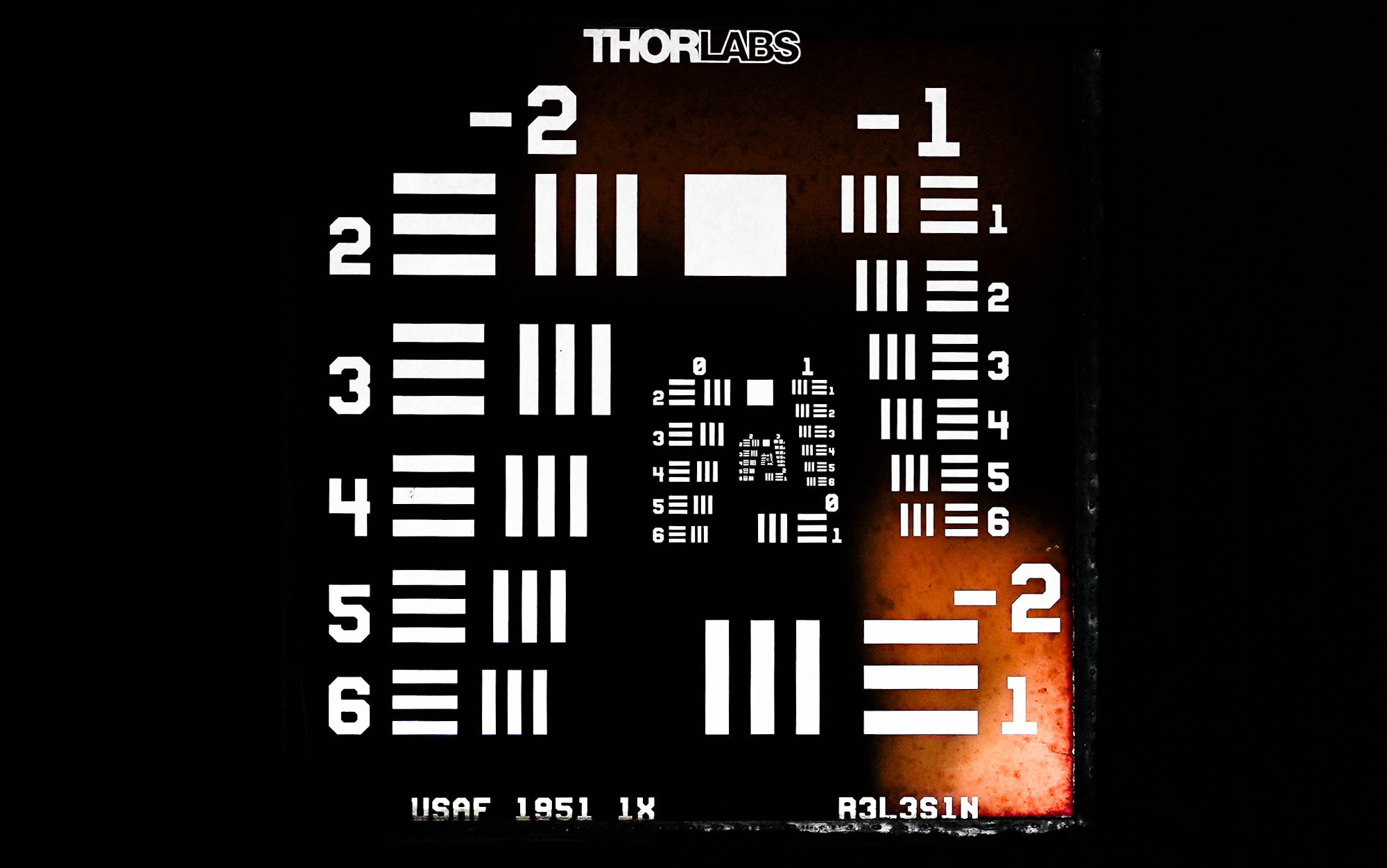
Just as with our other Optics Test categories, we put all submissions through the same criteria. First, we measure optical resolution, using the diminishing black-and-white lines of a 1951 Air Force Resolution Target to score the optical performance of each submission. We also measure the low-light performance of each LPVO scope by mounting them to tripods and focusing them as a group at 200 yards at a black-and-white resolution target at twilight, all in order to measure the brightness of the glass. As we discussed, neither resolution nor low-light performance are deal-breakers for this category, but both criteria provide valuable insights into the optical performance of the scope.
Then we take each submission to the shooting range. We put each LPVO through the same regimen of accuracy testing on bullseye targets, tracking, and return-to-zero assessment on a 10-minute grid, but we spent relatively more time on shooting drills to assess their combination of instinctive aiming, precision, and versatility. These included rapid target transition drills from standing, seated, and prone positions, followed by a big-bore instinctive shooting drill in which we walked a target course of steel plates positioned anywhere from 20 to 70 yards, and when a referee blew a whistle, the shooter had to find and hit a target within 5 seconds.
We break our 10-point scoring into four general categories:
- Optical performance (15 percent of total grade)
- Aiming system (a whopping 60 percent of total grade)
- Design (15 percent)
- Value (10 percent)
The average of these categories is the basis of our grades, detailed below.
Optical performance includes the resolution and low-light tests plus the more subjective assessments of image quality and brightness. Aiming-system performance assesses interior (reticle design, visibility, and utility as well as illumination) and exterior aiming system (turret positivity and indexing, parallax adjustment, zero stop), precision, and shootability. Design considers the exterior finish, interior blacking, mounting dimensions, and durability.
And then our price/value score rates how much scope — along with warranty and amenities such as rings, extra turrets, and lens covers — you get for your money. The LPVO that gets the highest overall score wins our editor’s choice award for the best in the category; the optic with the highest price/value score wins our Great Buy recognition, and we give other awards based on specific attributes.
How We Grade LPVO Riflescopes
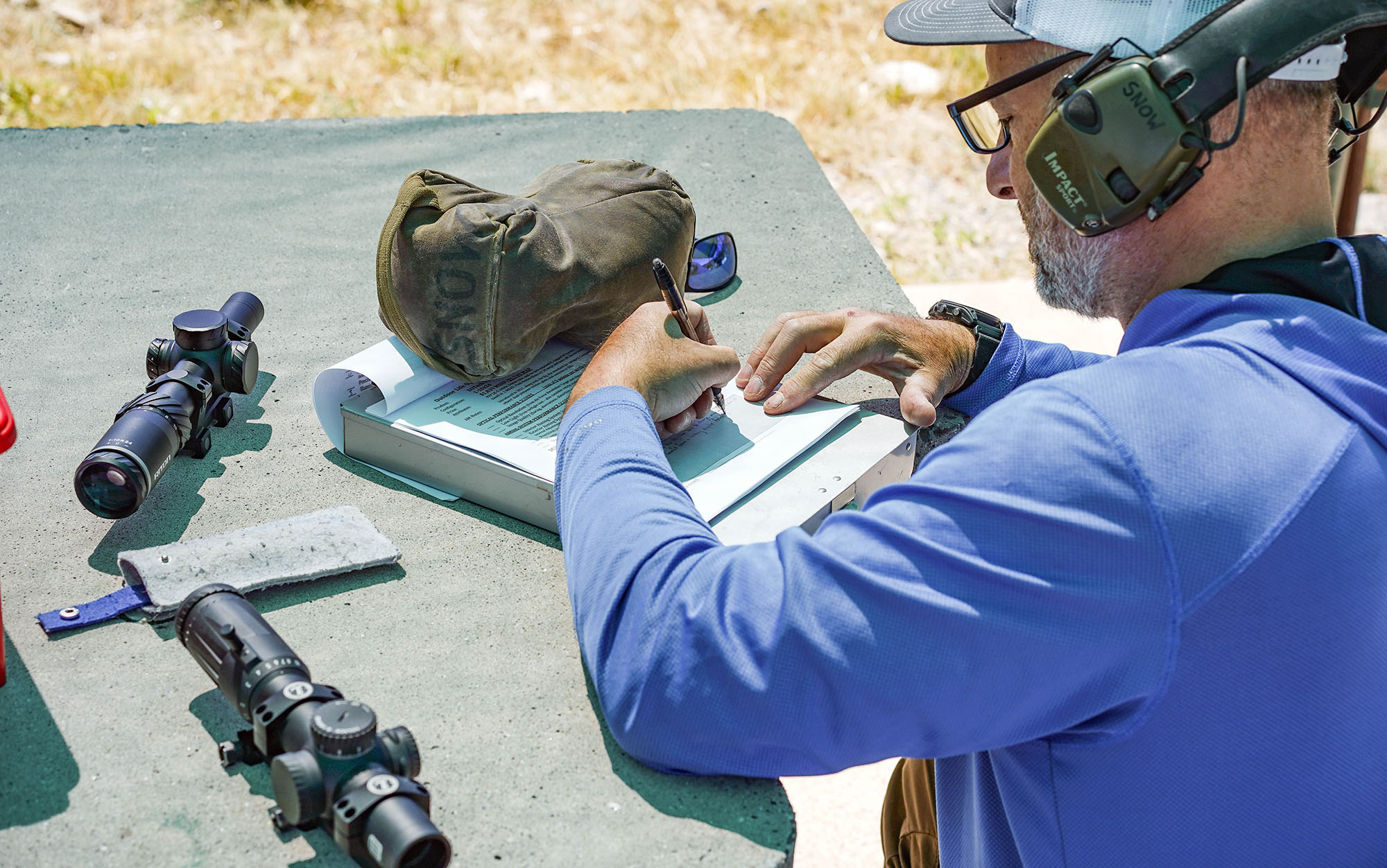
Our 100-point evaluation adds up to a total numeric score, but we translate those to grades for each submission. Our optical performance grade combines the scores from resolution, low-light, and image quality. Our aiming system performance grade aggregates the interior/exterior aiming system, precision, and shootability scores. The design grade considers construction, innovation, versatility, and durability. And then the price/value grade is our good-deal grade.
To earn an “excellent grade,” the average of that category must be 9 or higher, which is extremely hard to achieve. “very good” is an average score of 7 to 9. A “good” grade is 5 to 7. Our “fair” grade is 3 to 25, and “poor” is anything under 3.
Best LPVO Riflescopes: Reviews & Recommendations
Editor’s Choice: SAI-6 1-6×24
See It
Score Card
- Optical Performance: Very Good
- Mechanical Performance: Excellent
- Design: Very Good
- Price/Value: Good
Key Features
- 30mm tube
- First-plane RAF (Rapid Aiming Feature) reticle
- 9-step red center-cross illumination
- Capped turrets tuned to .1 MRAD click values
- 35 MRAD total adjustment range
- Parallax fixed at 110 meters
- Weight: 18 ounces
- Price: $1,492
Pros
- At 10 inches and 18 ounces, nicely sized
- Big grippy power-changing dial
- Excellent illumination at all intensities
- Ships with turret cover tethers and flip-up caps
- Reticle subtensions conform to VSOR rangefinder
- Ships with Tenebraex “killFlash” anti-reflection device
Cons
- Turret controls are tiny and hard to turn
- Some fishbowl aberration at 1-power
This LPVO is a complete package. While it’s intended as an AR scope — the ranging references in the lower left image plane are tuned to the dimensions of an IPSC target — we would gladly mount this on a turkey or slug gun. And its fast target-acquisition talents and expedition-grade build made it the runaway choice of testers for a dangerous-game rifle optic.

SAI is the optics branch of Armament Technology, the Canadian company that specializes in combat sights. The company’s martial DNA is all over this scope, from its rubberized turret-cap tethers to its aggressive first-plane Rapid Aiming Feature reticle.
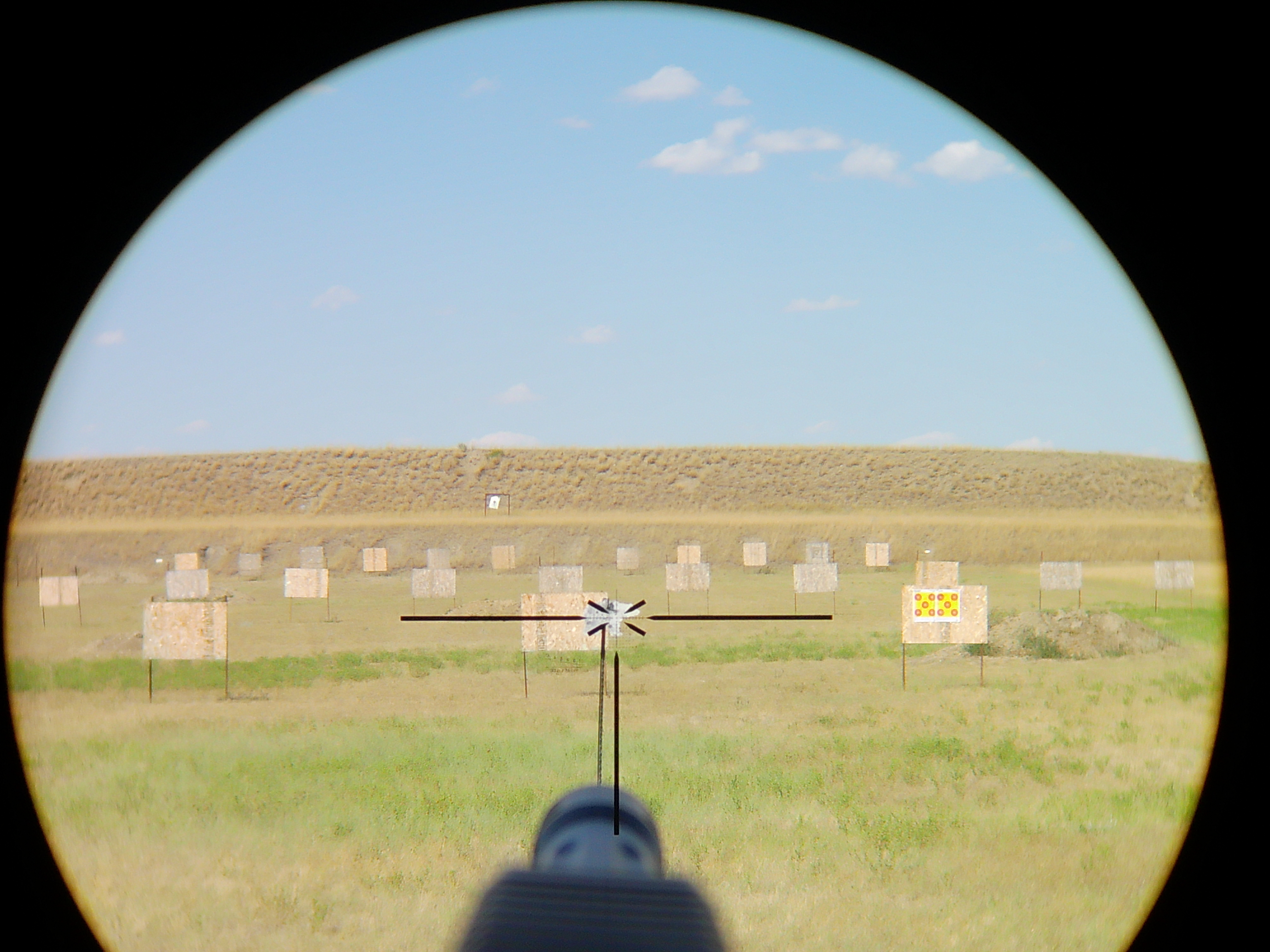
The reticle deserves its own paragraph. Tester Josh Ward said the 5.56 BDC reminded him of “the plasma rifle reticle from Halo” video games, and Scott Einsmann thought it could have been designed by his 4th grade self. The four super-bold extended triangles that all point to the center aiming cross “look hokey and like a marketing team designed it to look cool,” said Einsmann. “But holy cow, does it work. It sucks your eye to where you want bullets to go at 1X, even at 100 yards.”

We strapped the SAI-6 to a 450 Bushmaster bolt gun and put the scope through a dangerous-game simulation, walking up on a (steel-plate) grizzly bear through obscuring brush. When the shooter’s companion yelled, the shooter had to acquire the target and make a snap shot under simulated duress. Nearly every first- and second-round shot in this little game rang steel in less than 2 seconds behind the SAI-6.
The ranging grid in a corner of the RAF reticle is designed to be used in tandem with Armament Technology’s Vertical Subtension Optical Rangefinder system. Distance to a known 30-inch tall target (human torso) can be determined by bracketing the target in the rangefinder. We found the system to work well with steel targets of known dimensions, and it would work just as well with the spine-to-belly dimensions of a large deer or an elk.
The reticle’s illumination, blazing from daylight bright to barely visible for nighttime operations, is one of the best in the test, with intensity controls that are positive and levels separated by off positions.
We gave the scope some demerits. The turret controls are tiny and maddeningly hard to turn. We’d like a throw lever to enable even faster magnification changes. At just under $1,500, this is a pricey scope, though we reckoned that the SAI brings just as much or even more to the party than the other three LPVO scopes in our test priced at a similarly aspirational level.
For its bombproof build, its responsive controls, and its excellent glass, but especially for its extremely useful reticle, we gave the SAI-6 our Editor’s Choice award for the top LPVO in the field.
Great Buy: Vortex Venom 1-6×24
See It
Score Card
- Optical Performance: Good
- Mechanical Performance: Excellent
- Design: Very Good
- Price/Value: Excellent
Key Features
- 30mm tube
- Second-plane AR-BDC3 reticle
- Capped turrets tuned to .25 MOA click values
- 140 MOA total internal adjustment
- Parallax fixed at 100 yards
- 6-step red illumination
- Weight: 19.5 ounces
- Price: $300
Pros
- Reticle configured for AR platforms
- Ships with flip-up lens caps and throw lever
- 10.3 inches and 19.5 ounces
- Reticle tuned to ballistics of 5.56 loads
- At about $300 real-world price, a screaming deal
Cons
- At low magnifications, image fishbowls
- Reticle a little small for longer-range precision
You could subtract points from this scope for its very narrow utility. Its AR-BDC3 reticle in the second plane is tuned to the ballistics of standard loads from a 5.56 with velocities from AR carbines. With that use-case in mind, and with a 100-yard zero, the reticle’s holdover references should drop a 55-grain bullet into your target out to 650 yards.
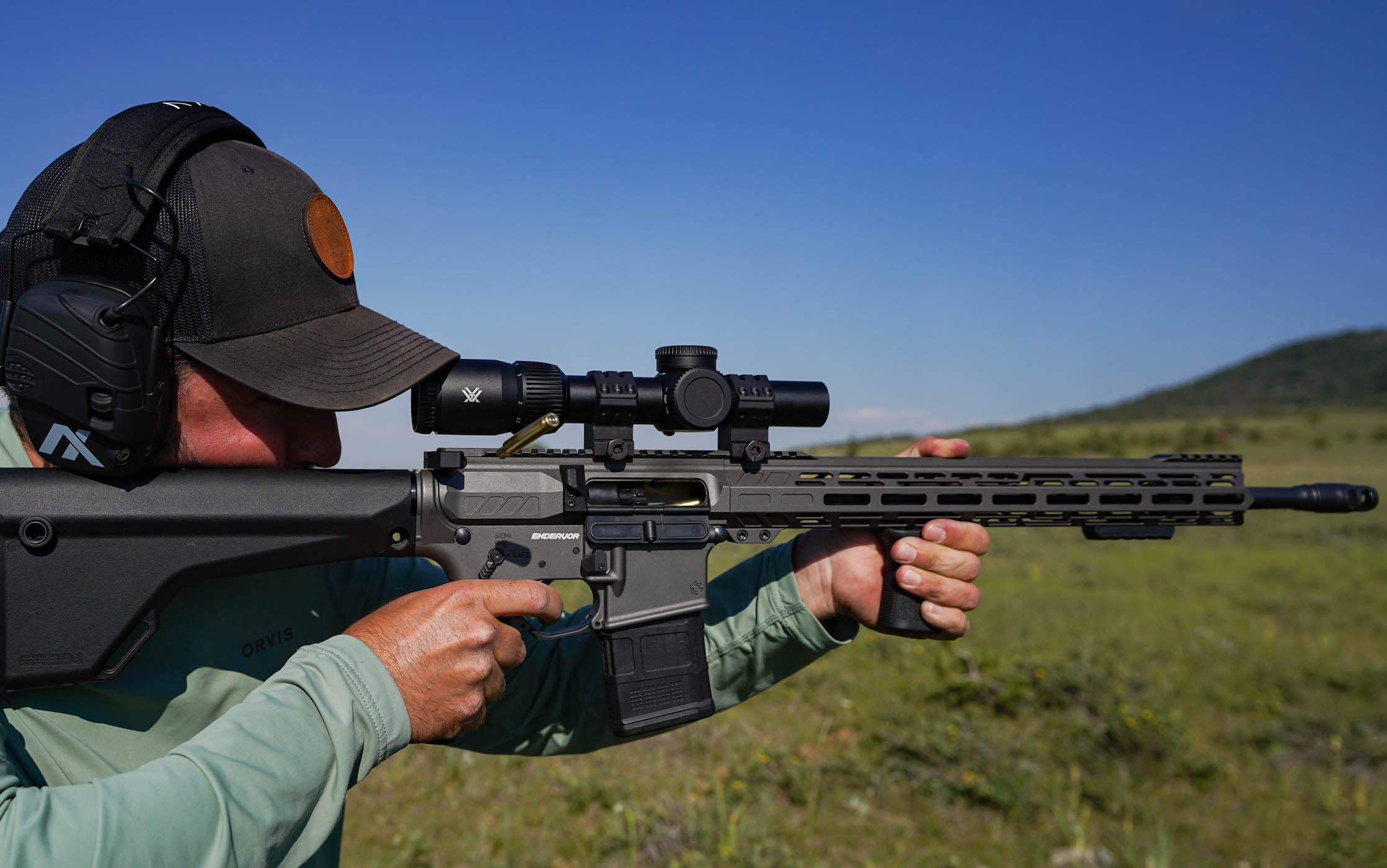
While the Viper was one of the best AR-specific LPVOs in our test, it would be a mistake to limit your consideration to AR-15s. The scope is a wonderful rimfire optic, and we found it to be fast and reliable for dangerous-game hunting. While we might not put it on a hard-bucking turkey shotgun, it’s suitable for straight-wall cartridge rifles.
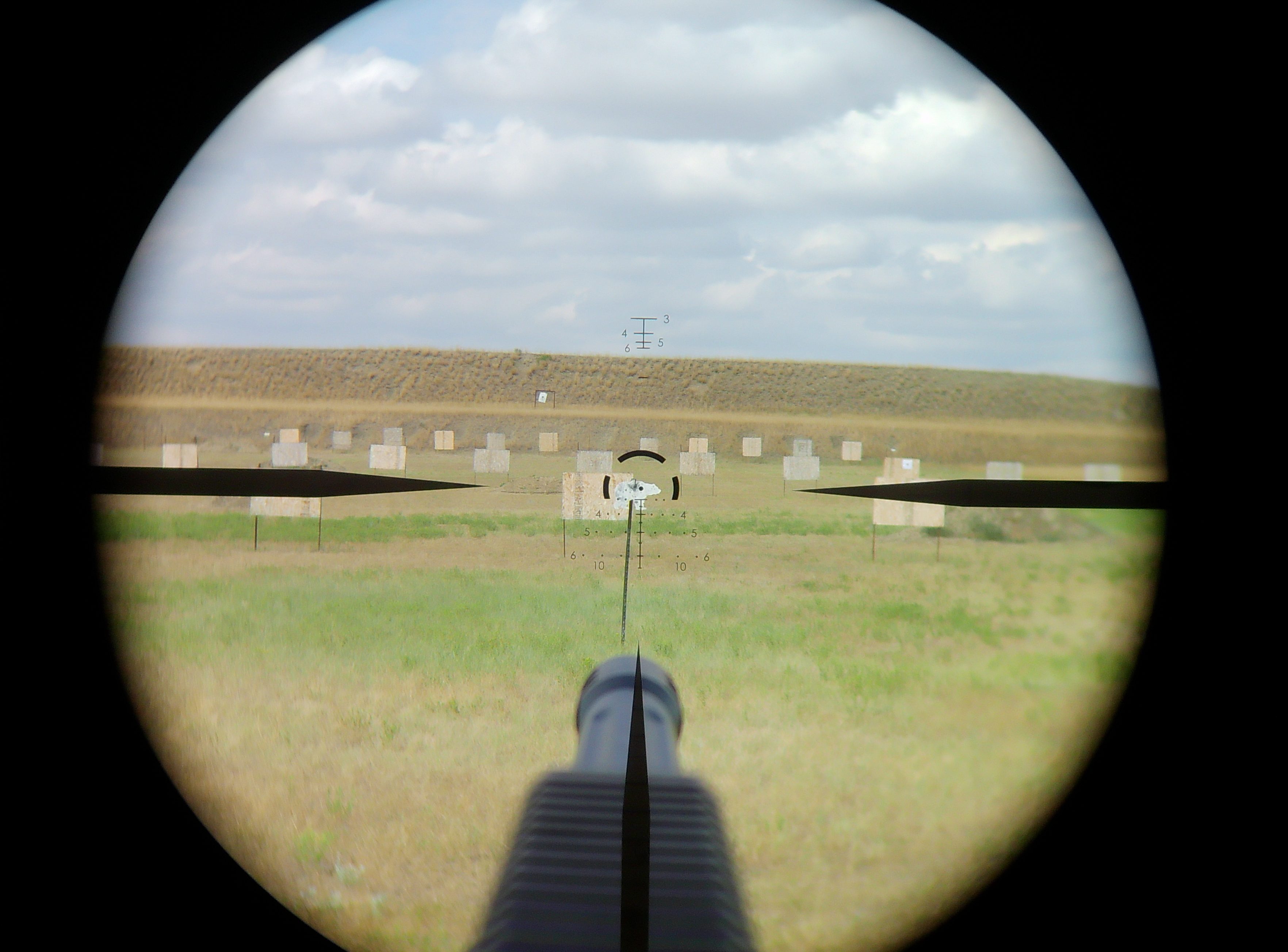
The heart of the scope is an MOA-based segmented circle. The 16-MOA circle halfway surrounds a floating 1-MOA illuminated dot. Non-illuminated hashes provide holdovers at 200, 400, 500, and 600 yards with a 100-yard zero and windage dots represent holds for standard-value right-angle winds. Note that the subtensions work only at the scope’s highest power.
The scope’s controls received mixed reviews, as you might expect in a price-point optic. Most testers recorded indistinct turret clicks and noted the illumination is useful only at the highest and lowest intensities. We also noted significant distortion at 1X, with convex “fishbowling” curving the image when we panned across the landscape. Do it quickly, and you can feel almost seasick.
But the Vortex has so much value, and brings attributes to the game that many of its peers couldn’t bring at twice the price, that it is the consensus pick for our Great Buy award as the screaming deal of this year’s LPVOs.
Best AR Carbine Scope: Leupold Mark 4HD 1-4.5×24
See It
Score Card
- Optical Performance: Very Good
- Mechanical Performance: Excellent
- Design: Very Good
- Price/Value: Good
Key Features
- 30mm tube
- Second-plane FireDot TMR (Tactical Milling) reticle
- Exposed locking elevation turret, capped windage turret tuned to .1mRAD clicks
- ZeroLock elevation turret
- 48 MIL internal elevation adjustment
- Parallax fixed at 150 yards
- 8-step push-button red FireDot center-dot illumination
- Weight: 18 ounces
- Price: $1,150
Pros
- Versatile hash-based TMR reticle (available in BDC and circle-dot reticles)
- Bright and precise .5 MIL center dot
- 18 ounces
- Liberal mounting dimensions
- Clear and useful turret indexing
Cons
- Limited magnification range
When Outdoor Life’s test team can only find a single quibble — more magnification, please — in a scope, you know you’ve checked a lot of boxes. That’s the case with the LPVO entry in Leupold’s new Mark 4HD family. This do-everything scope is the embodiment of an LPVO’s versatility.
That’s mainly because the hash-style first-plane milling reticle is capable of just about any shooting situation, from close to fairly far. Looking for a hard-wearing AR scope? The close-quarters talents of the nicely illuminated reticle and dime-bright glass handle both dark-room situations and bright daylight. Want a durable and versatile scope for your Cape buffalo rifle? This is a great choice, and it has enough mid-distance talents to double as a fair plains-game rig.

Our test sample contained the illuminated FireDot TMR, which stands for Tactical Milling Reticle. Shooters conversant with MIL-based subtensions will fly through a 3-gun course with this reticle. The 1-4.5 Mark 4HD is also available in a second-plane FireDot BDC with holdover hashes at unintuitive holds of .84, 1.3, 1.81, 2.95, and 4.24 MILs and second-plane HPR-1 MOA-based circle-dot reticle.
Each reticle has its uses, and its fans, but for all-around utility the TMR is hard to beat, though our precision work was limited to about 250 yards because of the 4.5X magnification ceiling.
Center-dot illumination runs the gamut from muted for low-light work to blazingly bright for mid-day shooting. Turret performance was among the best in our test, with positive clicks. The quick-deploy exposed elevation turret locks in place with Leupold’s proven ZeroLock system.
The Mark 4HD’s glass was very good, with most shooters commenting on its clarity and lack of glare and flaring. We like the throw lever for quick magnification changes, the light 18-ounce build, and the overall durability of the scope. Add a couple more Xs to the 1-4.5X, and it might well be the perfect LPVO.
Best Premium LPVO: Maven RS.6 1-10×28
See It
Score Card
- Optical Performance: Very Good
- Mechanical Performance: Very Good
- Design: Good
- Price/Value: Fair
Key Features
- 34mm tube
- First-plane CFR2-LPI reticle (also available in MOA-3 reticle)
- Pull-to-turn exposed elevation turret, capped windage turret
- Turrets tuned to .1 MRAD click values
- 29 MIL (100 MOA) elevation adjustment
- Parallax fixed at 100 yards
- Red and green center circle/dot illumination
- Not available until October 1
Pros
- Re-zeroable and zero-stopped turrets
- Removable throw lever
- Excellent turret tactility
- Excellent glass
- Reticle useful for close-quarters and mid-distance precision
Cons
- At $1,600 one of the pricier LPVOs in the field
- A large and heavy scope
This scope is almost too pretty for the sort of grubby, knock-about work that LPVOs are asked to do, from bumbling around in the dark to riding shotgun — literally — in a ranch rig or a Humvee. The new Maven — it will be introduced to the world in early September — would be at home in a Tiffany’s showroom. Its lines are striking, its engraving nearly perfect, and its stylish pewter highlights popping against its matte-black tube.
Its manners are just as refined. Its platter-sized turrets dial with the most agreeably positive clicks in the field, and the power-changing wheel — enabled by a sculpted throw lever — turns with hydraulic ease.

Just as you might say about a prospective mate, it’s just as lovely inside as out. The first-plane reticle is sharply etched and stands out cleanly against even cluttered backgrounds. Its illumination, with five intensities of both green and red, further enhance its visibility. Our sample had Maven’s excellent CFR2-LPI reticle with MIL-based references. The scope is also available in a MOA-3 version.
I’ve enjoyed the CFR-MIL in Maven’s big 5-30×56 scope, which splits the difference between a precision target rig and a long-range hunting scope, though the busyness of the tree-style reticle is better suited to slow-fire situations. I’d have to say the same of the reticle in this LPVO configuration. At lower powers, and with the appropriate illumination, the scope works as one of the best point-and-shoot quick-acquisition scopes in the field. But at its highest power, there’s so much going on in the reticle, with full, half, and quarter MIL holds and a wilderness of dots and hashes, that the reticle fights the ability of the scope to make snap shots. The somewhat simpler MOA-based reticle may be a better choice for this configuration.
With its immense 34mm tube and 10-times zoom range, we wondered about use-cases. It’s a lot of scope for an AR carbine. We’d happily mount it on a dangerous-game rifle, but worry the exposed elevation turret might move in the field, even though it locks smartly in place. And the Maven is simply way too nice for a 3-gun competition scope.
Then there’s its price. At $1,600, the market for an LPVO of this refinement is limited, and I’d wince the first time I put a mark on such a lovely and expensive unit. The RS.6 line is new to Maven, and if this is a representative of the new optical family, I can’t wait to see other configurations that combine high performance with elegant styling.
Sig Sauer TANGO6T 1-6×24
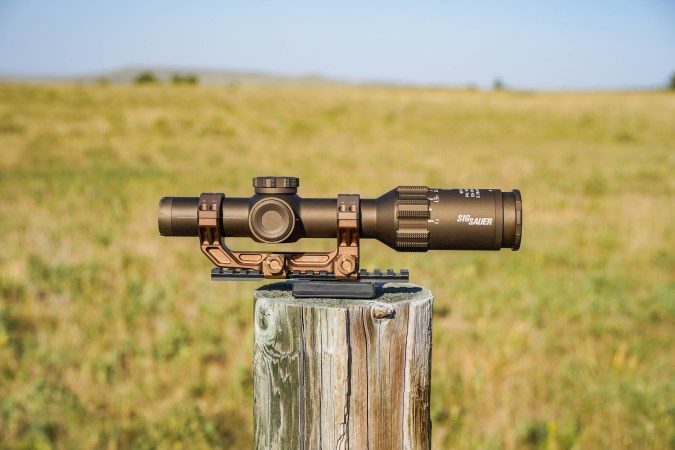
See It
Score Card
- Optical Performance: Good
- Aiming System: Very Good
- Design: Very Good
- Price/Value: Good
Key Features
- First-plane Hellfire DWLR-556 reticle
- Inverted horseshoe reticle tuned to 5.56 ballistics
- 30mm tube
- Pull-to-turn illumination
- Capped turrets tuned to .2 MRAD click values
- 31 MRAD total internal adjustment
- Parallax fixed at 300 meters
- Weight: 22 ounces
- Price: $1,700
Pros
- Battle-proven design
- Ships with ALPHA4 cantilever mount
- 11-step illumination (nine daylight, two night-vision)
- Good glass
- Liberal mounting dimensions
- Flat dark earth color
- Mounting line on side of tube reduces cant
Cons
- Reticle utility is limited
- At lowest power, the reticle is hard to see
- At over $1,700 street price, an expensive scope
The Sig TANGO6T was not a runaway favorite in last year’s test, and its fairly limited utility made it one of the least likely scopes to win what is ultimately a test of versatility.
But this tight and bright scope stacked up points by doing a number of things pretty well, and it’s a testament to that niche reticle — its drops are tuned to the ballistic parabola of a 5.56 NATO bullet with a muzzle velocity of 3,210 fps in a 24-inch barrel — that testers recommended it for a dangerous-game rifle, a lever gun, and since the test, it’s found a home on my .450 Bushmaster.
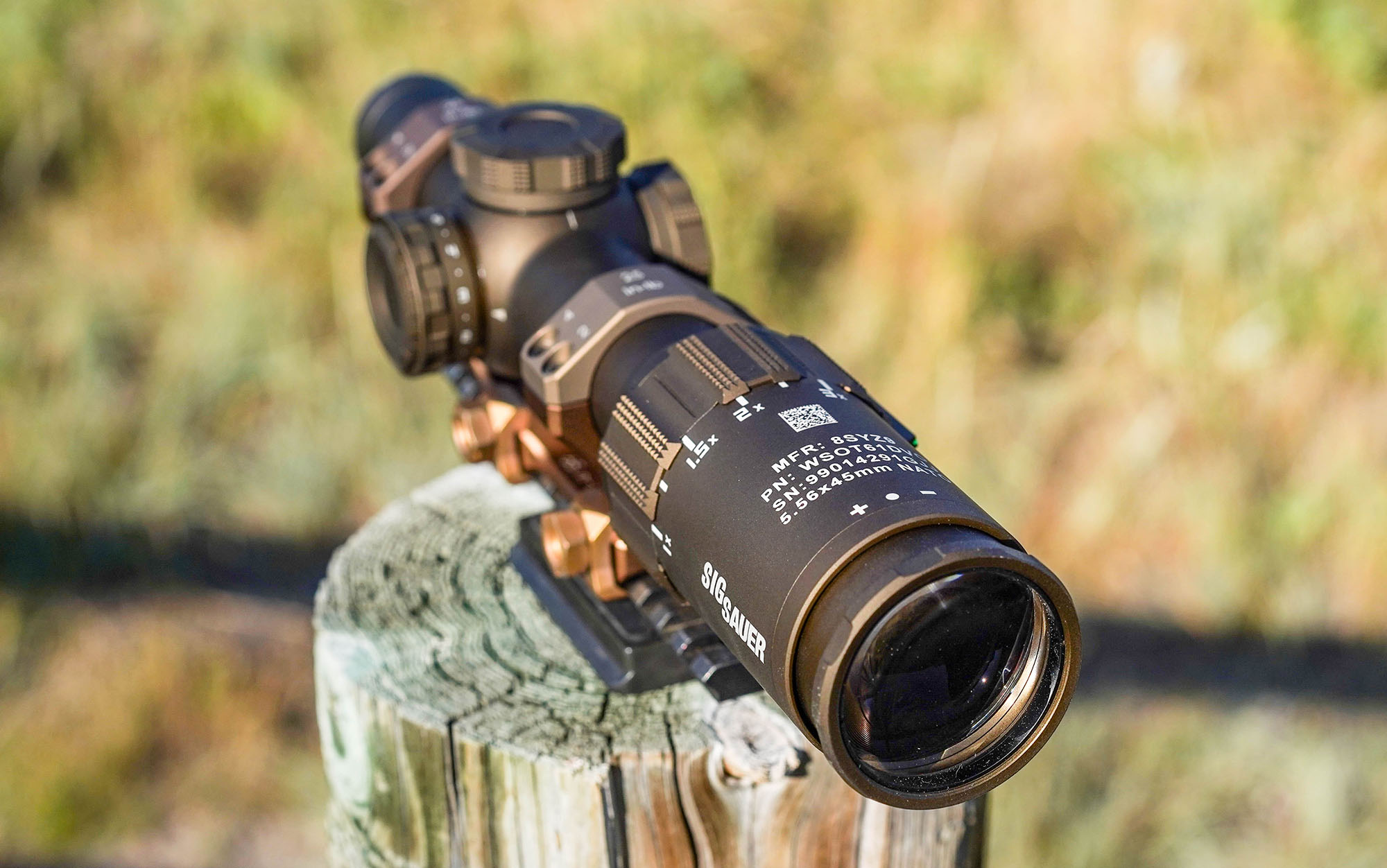
We liked its oversized controls and their movement. The big, grippy power-changing ring is easy to manipulate with gloved hands. The capped turrets turn with authority, thanks to their oversized diameter. And the illumination control turns with positivity, and turns off between intensity levels. We also liked the indexing on the scope. The zero indication is easy to see, the power-changing ring has half-magnification hashes to further aid in precision. And the white mounting line on the outside of the flat dark earth tube is a simple and smart aid to ensure that you don’t introduce cant to the scope as you position it in rings. We wish more brands would employ this feature.
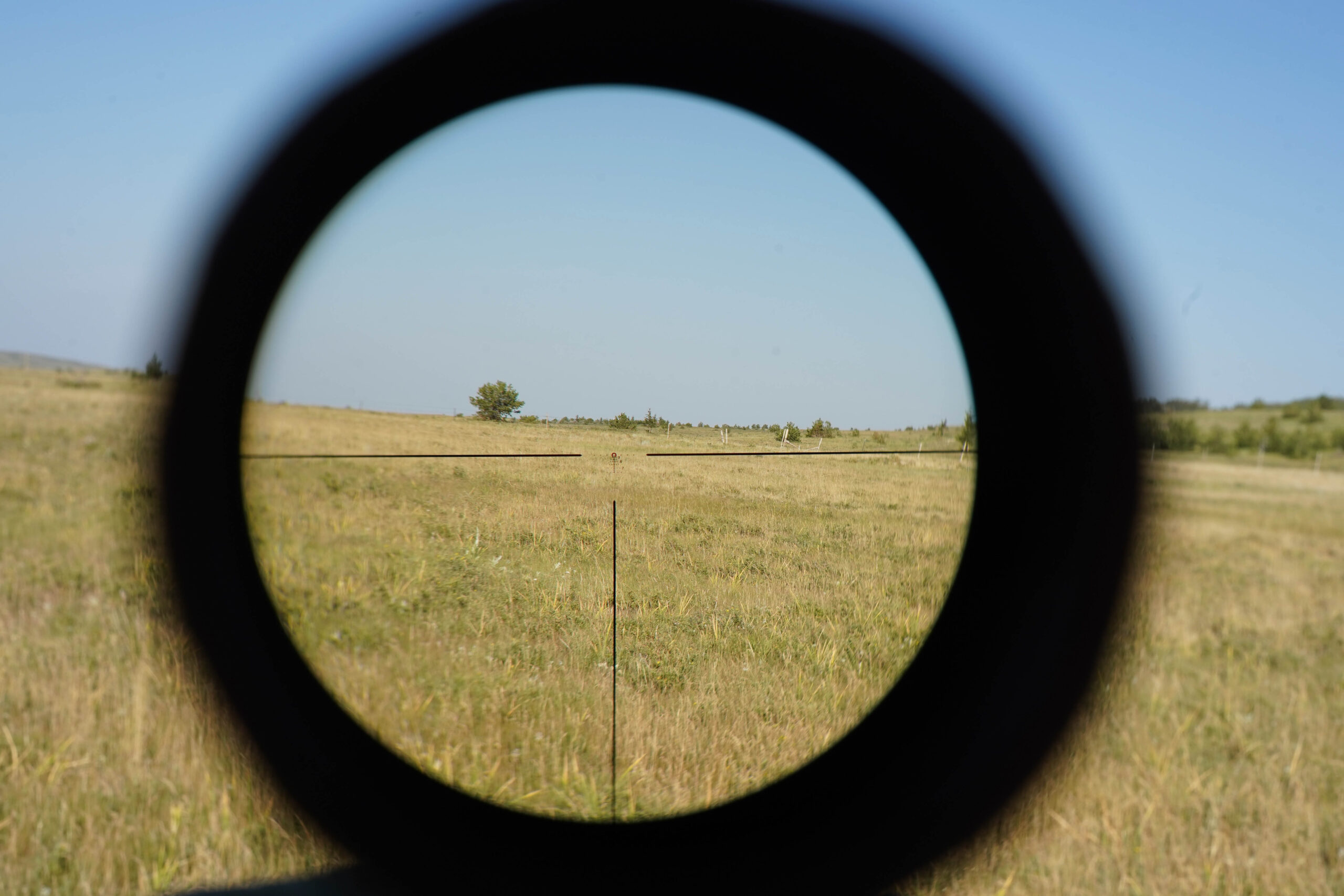
The class of Japanese glass that Sig uses in this scope is good, which made us wonder why the TANGO6 received lower-than-expected resolution and low-light scores. The scope made up ground with high construction, durability, and design scores. We recognize that the TANGO6T is the civilian version of a scope that has served the U.S. military branches as their preferred Direct View Optic. That category requires a minimum magnification of 1X with no rounding (or fisheye distortion) and a maximum magnification of 6X.
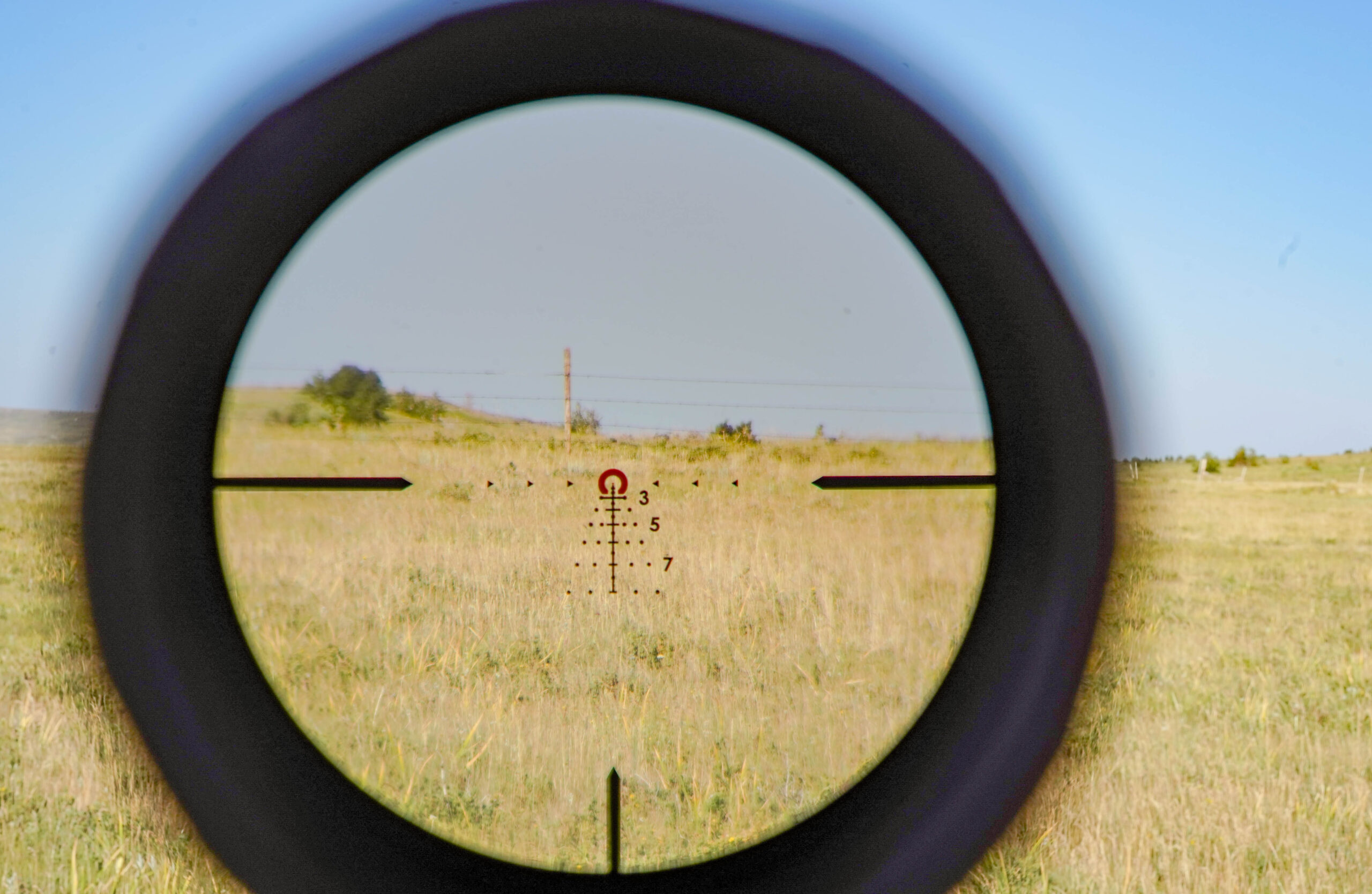
The inverted horseshoe Hellfire DWLR performs as an illuminated red-dot sight from 1-3.5X, when the first-plane references are too fine to see clearly. But from 4 to 6X, the bullet drops and windage dots are easy to deploy. With a 100-yard zero, the scope gives 5.56 shooters drop values out to 800 yards, with corresponding windage marks for a 10 mph crosswind. Our favorite combination of instinctive shooting and precision is about 4.5X, when the center aiming point provides fast target engagement, the field of view is wide enough to receive peripheral information, and you can still see those precision references.
The Sig was our favorite scope to use in dynamic target transition drills, and it performed very well on our big-bore instinctive shooting range.
The Sig received low price/value marks, largely because its price — it retails for $2,200 and sells for a street price of a little over $1,700) — puts this out of reach of casual shooters. The addition of an excellent cantilever mount and a set of smart lens caps that feature magnets that allow the lids to stow out of the way when the scope is deployed are both nice additions, but don’t change our mind that the TANGO6T is a little overpriced.
If you’re looking for a hard-wearing LPVO for a .223 or 5×56 AR, and you can afford the Sig, this is an excellent choice. But it’s also a fine scope for a wide range of other close-range shooting situations.
Best for Competition: Nightforce NX8 1-8×24
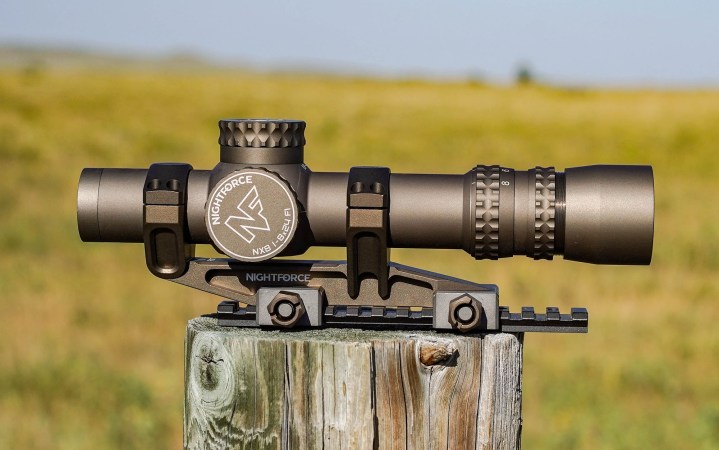
See It
Score Card
- Optical Performance: Fair
- Aiming System: Very Good
- Design: Very Good
- Price/Value: Good
Key Features
- First-plane FC-DMx reticle
- 30mm tube
- Capped turrets tuned to .2 MIL click values
- 30 MRAD total internal adjustment
- Ten-step illumination
- Weight: 17.6 ounces
- Price: $1,850
Pros
- New capped elevation turret
- Segmented center circle acts as red-dot aiming point
- At higher mags, 1MRAD aiming grid comes into view
- Excellent turret feedback
- Excellent indexing
- Stylish dark earth color
- Battle-worthy durability
Cons
- At over $1,800, a pricey scope
- Difficult to focus inside 100 yards
- Utility limited to precision shooting
The NX8 has been around since 2017, but this version features a number of significant upgrades. First, it has a capped elevation turret, a response to shooters who wanted insurance that elevation adjustments wouldn’t accidentally move during transit or rough handling. Second, it’s offered in a sexy dark earth color in addition to the classic black. But the main change is the availability of the FC-DMx reticle, previously available only in the higher-grade ATACR scope.
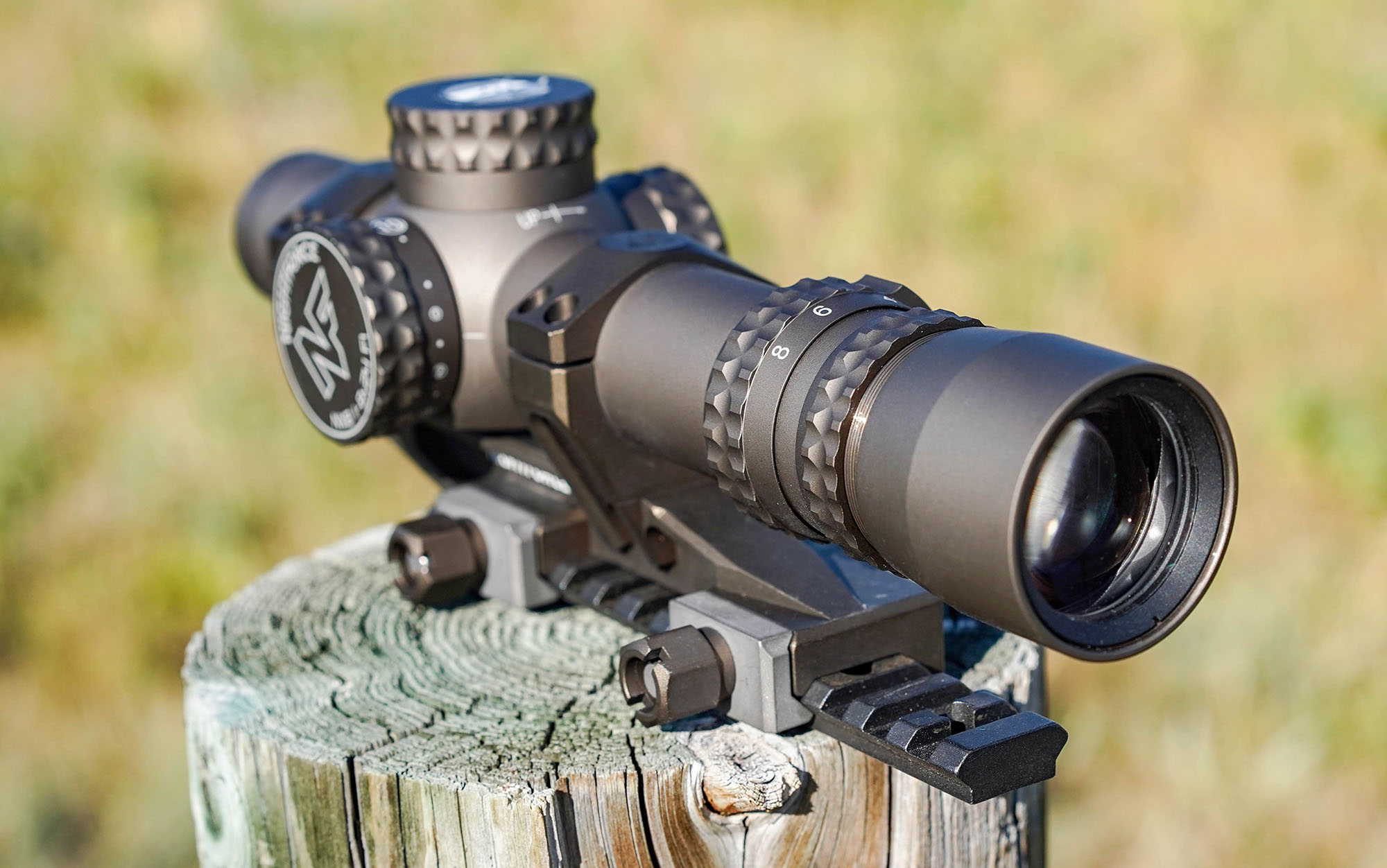
The reticle is worth your attention. It’s the best precision reticle in this category, which is dominated by first-plane reticles that offer fast aiming at low powers and close-enough precision at higher mags. The FC-DMx does both pretty well, but its superpower is offering a mother-ton of aiming points at 6X. The heart of the FC-DMx is a segmented circle that can be blazingly bright with the highest illumination intensity. Still, it really comes into its own at about 4.8X when the aiming grid becomes visible. The 1 MRAD grid allows for 10 MILS of holdover and windage holdoff, and if you want to get really crazy, there are holds for 15 and 20 MILS at the bottom of the field of view.
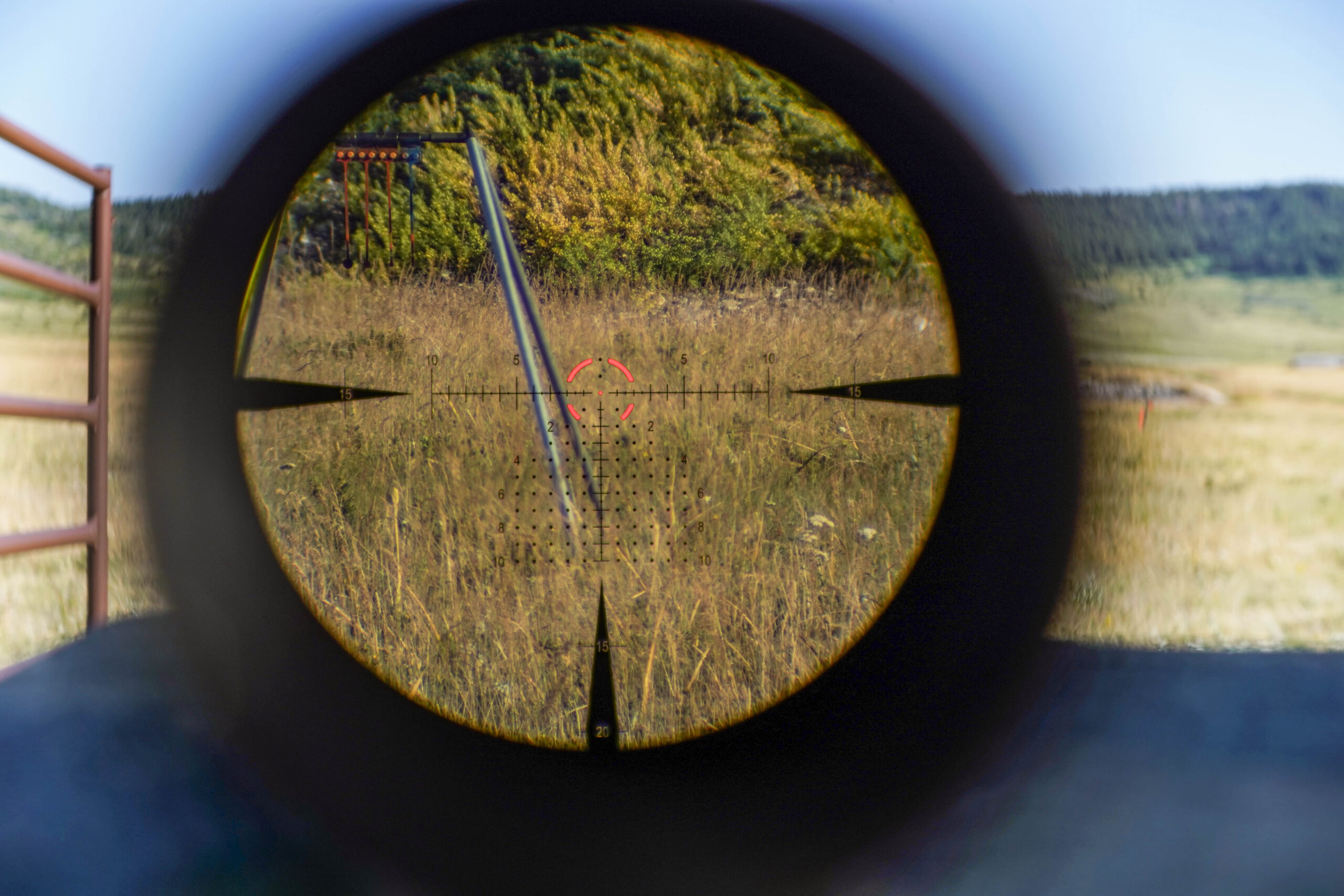
There’s no other LPVO reticle in our test with this level of precision or scale of aiming possibility. The rest of the scope is equally noteworthy. The turrets track with repeatable precision and the turrets are crisp and positive. The illumination control is similarly tactile. Testers liked the Nightforce’s indexing and overall handling, but noted that the magnification knob needs a throw lever because the scope mounts so low to the rifle that it’s hard to grip the dial.
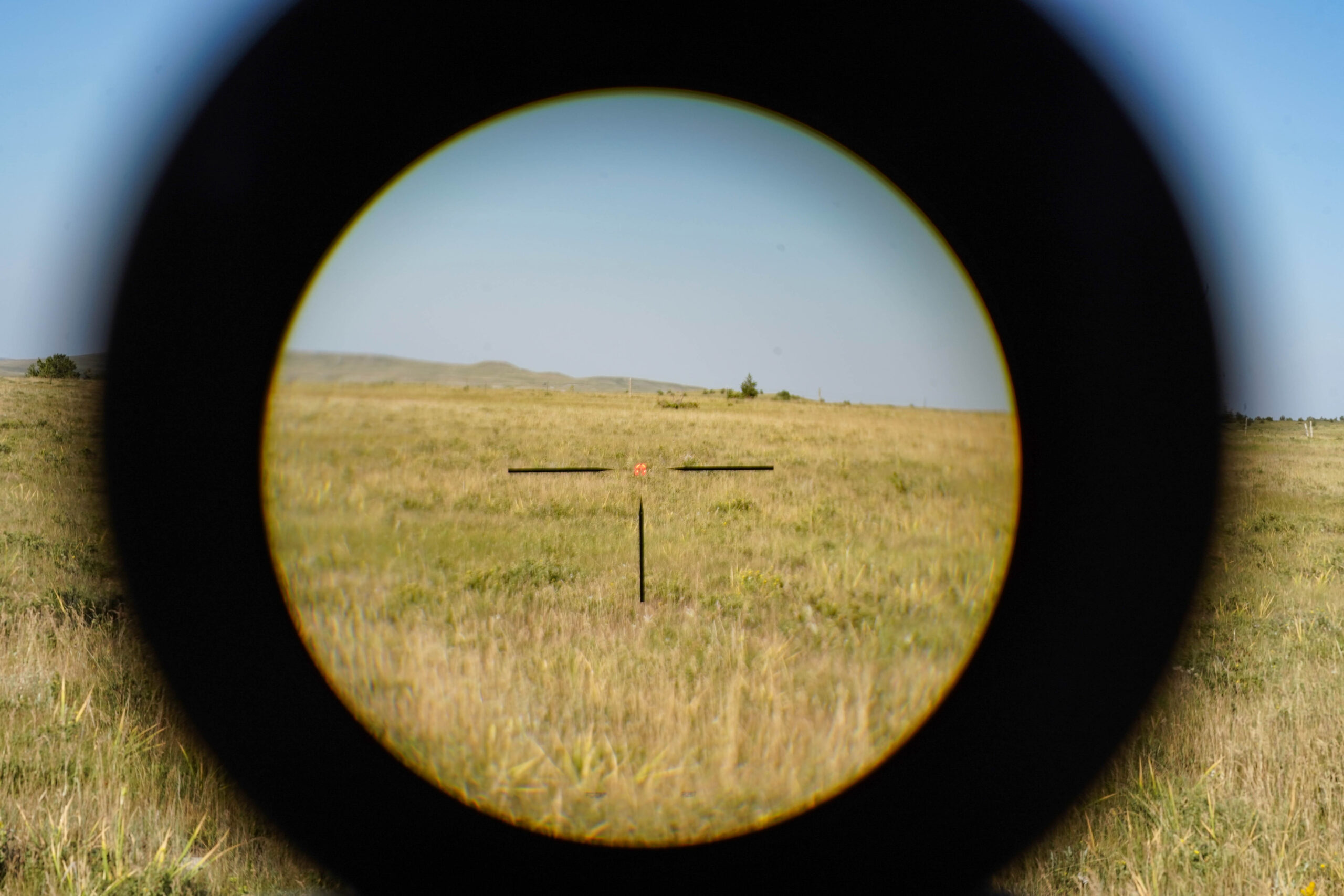
Testers struggled with focusing both the image and the reticle, and felt the NX8 was pretty pricey given its fairly limited utility as a low-power precision scope. But with all that, it’s a great choice if you intend to do much long-range target work with an AR.
EOTECH Vudu X 1-6×24
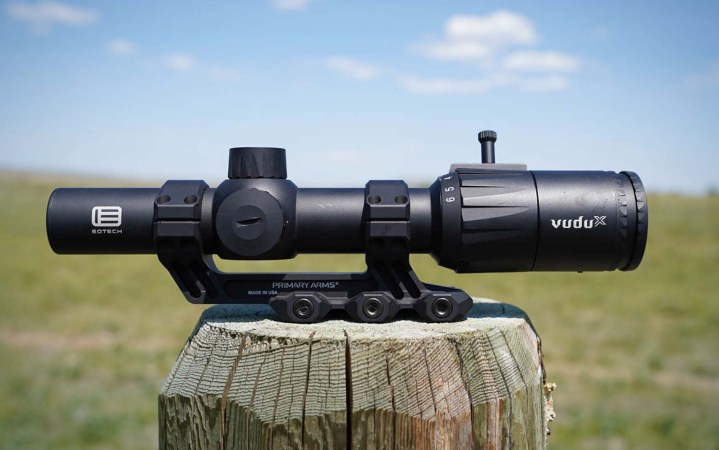
See It
Score Card
- Optical Performance: Good
- Mechanical Performance: Good
- Design: Very Good
- Price/Value: Good
Key Features
- 30mm tube
- Second-plane BD1 reticle
- Capped re-zeroable turrets
- Turrets tuned to .5 MOA click values
- 160 MOA elevation adjustment
- Fixed parallax
- 10-step red center-cross illumination
- Weight: 17.8 ounces
- Price: $800
Pros
- Re-indexable turrets is nice touch
- Illumination has off stops between intensity steps
- Ships with removable throw lever
Cons
- Second-plane reticle too fine for precision work
- Turret clicks are mushy
- Magnification dial turns very hard
EOTECH was an early adopter to the LPVO game. The brand’s original Vudu set the bar for performance and design of the platform, and we’ve been amused to see how many submissions conform to the first-plane segmented-circle design of the original.
But that OG Vudu was a pricey number. Sourced in Japan, its glass and controls put it out of touch of most shooters. EOTECH has solved that problem with its new Vudu X, sourced in the Philippines and offered to the market at about half the price of the original.
The new scope has also lost something in translation. The Vudu X has underwhelming glass and its controls are alternately vague (turrets) or too tight (magnification dial). It’s fair to acknowledge that our test sample was a prototype, and production models will likely solve some of the shortcomings we recorded.
The BD1 (bullet-drop) reticle has a lot of appeal for snap shooters. With a 50- or 100-yard zero, the circles represent bullet drops at known distances. It’s a fast, intuitive, and smart system not only for dead-hold shooters but for hold-over shots. But we’d like to see a bolder reticle. In its second-plane configuration, its references are hard to see at every magnification, which is important since its ballistic drops are valid only at highest magnifications. This is a great reticle that might be better in a first-plane focal system.
We love the turrets’ .5 MOA click values, which is a much more realistic increment for LPVO-platform scopes than .25 MOA clicks. And the center-cross illumination is good, though we’d like to see true daylight-bright intensity.
It’s a decent start for an optical family we hope gains traction and becomes the new shorthand for the best products of the category, just as the original Vudu was. But EOTECH has some work ahead of it to make this version of the Vudu as tight and as field-worthy as its predecessor.
Best for 3-Gun: Trijicon Credo 1-10×28
See It
Score Card
- Optical Performance: Good
- Mechanical Performance: Excellent
- Design: Very Good
- Price/Value: Poor
Key Features
- 34mm tube
- First-plane Segmented Circle
- Exposed elevation, capped windage re-zeroable turrets
- Turrets tuned to .1 MRAD click values
- 29.1 MRAD elevation adjustment
- Parallax fixed at 100 yards
- Red and green center-cross and circle illumination
- Weight: 21.2 ounces
- Price: $2,150
Pros
- Tool-less turret rezero system
- Throw lever
- Clear and fast turret indexing
- Useful illumination at all intensities
Cons
- Non-locking elevation turret
- At $2,150, the most expensive LPVO in the test
If there’s a Lexus of LPVOs, this is it. Velvety controls that turn with precision and authority. Very good glass. Positive turrets that are built around brass gearing, and a cool, retrained style elevate this scope to the aspirational level.
We’re not sure all those luxury appointments quite justify its eye-popping price tag, but its butter-smooth handling is in a different class than most scopes in the field. Like the Maven, we worried about dinging and abusing this scope, and we wonder if that same concern for its welfare would extend to field use. Which made us wonder who would buy this capable LPVO.
Possibly veterans who have had positive experience with Trijicons (think ACOGs and RMR reflex sights) and know the dependability and durability of the brand. Indeed, we gave high marks to the Credo on those qualities, plus overall versatility.
The Segmented Circle reticle is possibly the best example of the first-plane utility of the design in our test. At lower magnifications, and with the illumination fully blazing, the scope acts almost as a red-dot, enabling quick target acquisition, the segmented circle helping to center the target. But zoom up to about 3X and you get the best of both worlds, fast shooting and decent precision references. From 7 to 10X, the reticle’s milling features dominate.

The reticle has half-MIL steps and fully 30 MILs of elevation holds and 30 MILs of windage holds on either side of the floating .145 MIL dot inside the center-cross aiming point.
Turret performance is as satisfying as the reticle. The clicks are positive and precise, and the ability to rezero turrets in the field is a nice touch.
Given its high marks, we questioned the exposed unlocking elevation turret. It’s the rare shooter of an LPVO who is going to dial a shooting solution, and they generally have time to remove a turret cap to do it. The exposed dial that can be knocked off plumb in the field seems like an odd design choice in an otherwise excellent and versatile luxury LPVO.
Best for Long Range: C&H LPVO 2-12×24
See It
Score Card
- Optical Performance: Good
- Mechanical Performance: Very Good
- Design: Very Good
- Price/Value: Fair
Key Features
- 30mm tube
- First-plane FFP circle-dot reticle
- Exposed pull-to-turn re-zeroable and zero-stoppable turrets
- Turrets tuned to .1 MRAD clicks
- 34 MRAD internal adjustment
- Six-step LED center-circle illumination
- 10 yards to infinity side parallax adjustment
- Weight: 32 ounces
- Price: $1,350
Pros
- Extremely versatile reticle
- 2- to 12-power zoom range perfect for whitetail hunting
- Bombproof build
- At 10-12X, reticle has very useful holdover and hold-off references
- Mountable on AR carbine, lever gun, or bolt guns
Cons
- Reticle references not very visible until 6X
- At $1,349, a pricey scope
This freshman effort from C&H, a brand more familiar to readers as an AR-accessories business, is built with the Dedicated Marksman shooter in mind, but as we detail in our carbine-scope review, it has a ton of talent as a straight-wall cartridge scope.
As we noted, the C&H’s excellent reticle is built around caliber-agnostic references. For shooters spun up on milling, and adept at using ½ MRAD references, this reticle can drop bullets into targets at any distance or wind value. C&H’s first-plane circle-dot reticle makes an excellent snap-shooting rig at lower magnifications, especially with the center-circle blazingly illuminated. At higher magnifications, from about 8X to 12X, the reticle’s references guide precision shooters.

The scope is built for dialing, with big, beefy exposed turrets that lock positively but lift to turn with precise, tactile authority. Both turrets are re-zeroable, and the elevation turret has a stout zero stop.
The DNA of the scope pretty squarely descends from designated marksman utility. At lower magnifications it’s a useful quick-acquisition rig. But it’s really intended to engage mid-distance targets out to about 600 yards, guiding intermediate cartridges in the 5.56, 7.62, and .308 classes, and with this in mind, it’s a great choice for an AR-toting deer hunter or 3-gun competitor.
The reticle is a little busy for snap shots at mid-distance targets, and users will have to practice in order to parse their target from the grid of reticle dots and hashes. And we found the C&H controls to be a bit too stiff for fast field deployment, but we expect the turrets and power ring to loosen with a season of honest use. The side parallax is nice, and its ability to focus as close as 10 yards makes this a great air gun or rimfire scope. But we’d be just as happy with a fixed 100-yard parallax.
Its tactical heritage gives it the durability to handle the rigors of a late-season deer hunt or atop a hard-wearing ranch rifle. Its reticle is a very good alternative to caliber-specific second-plane reticles that lock users into a single load. Its square-jaw handling and wide versatility satisfies us that the C&H is just as suitable on a .45/70 as it is on a 7.62 gas gun.
Best for Predator Hunting: Hawke Frontier 30 FD 1-8×24
See It
Score Card
- Optical Performance: Good
- Mechanical Performance: Very Good
- Design: Good
- Price/Value: Good
Key Features
- 30mm tube
- Second-plane LRX Tactical FD reticle
- Capped re-zeroable turrets
- Turrets tuned to .5 MOA clicks
- 300 MOA elevation adjustment
- Parallax fixed at 100 yards
- 11-step center-dot fiber-optic illumination
Pros
- Insane amount of internal adjustment
- Reticle tuned to the ballistics of standard 5.56 loads
- Daylight-bright illumination
- Ships with premium metal flip-up lens caps
Cons
- Bullet drop works only at 8X
- At nearly $1,000 pricey for a fairly non-tactical scope
This fine scope should get a lot more attention than it probably will, simply because it doesn’t wear the gnarly battle-born exterior or brand imagery that appeals to the “tacti-cool” crowd. But the 5.56-specific drops in the excellent BDC reticle make this a great AR-platform scope, and our pick for the best predator rig of the LPVO field.
This 1-8X is one of a pair of 24mm LPVOs Hawke has introduced in the Frontier 30 family. The brand’s 1-10X sports an MOA-based hash-style reticle that’s less caliber-specific than the 1-8X Frontier 30. Both have excellent glass and mannerly controls. While we’re talking about variations on the theme, the 1-8X also comes in a #4 duplex with illuminated center dot. Do yourself a favor and check out the crazy number of SKUs that Hawke has in the Frontier line of scopes alone.
Nearly all the configurations have broad appeal. The 1-8-power version would make a great straight-wall scope and would be a fine turkey optic, though you may notice that Hawke has a turkey-specific scope. What Hawke calls its LRX Tactical Fire Dot is a great companion for an AR-15. Zeroed at 100 yards, the reticle has holds out to 500 yards. In field situations, the system is fast and precise enough that, even at 8X, you can see bullet strikes and adjust for fast follow-up shots.
The Hawke’s glass is good, and its pin-point illumination blazes in daylight and mutes way down for low-light engagement. Its fixed parallax simplifies in-the-moment shooting, and while we questioned the advertised 300 MOA of internal adjustment, we got nearly that amount of travel, a marvel for a 30mm tube.
This scope won’t light the world on fire, and we honestly thought it a bit underwhelming for its $999 price, but it’s a solid LPVO that will make any 5.56 shooter look good.
Best Entry-Level: Bushnell R5 1-6×24
See It
Score Card
- Optical Performance: Good
- Mechanical Performance: Good
- Design: Fair
- Price/Value: Very Good
Key Features
- 30mm tube
- Second-plane DD2-QA reticle
- Capped re-zeroable turrets
- Turrets tuned to .5 MOA clicks
- 60 MOA elevation adjustment
- Fixed parallax
- 6-step red illumination
Pros
- Off stops between illumination intensities
- Re-zeroable turrets is nice touch
- Segmented-circle reticle enables fast shooting
Cons
- Mushy turrets
- Needs throw lever
- Illumination could be more intense
Bushnell’s new scope family brings a lot to the game for either a first-time LPVO shooter or a shooter looking to pick up an extra scope. The R5 has decent illumination, re-zeroable turrets, a capable reticle that combines quick target acquisition with good precision talents, and connectivity to a ballistic app.
Those are the good attributes. As you might guess, especially at this price, there are some demerits. The reticle is faint, and would be much more useful in the second-plane configuration with bolder references. The power-changing dial is tight and could benefit from a throw lever. The turrets are mushy. And the illumination needs a couple extra intensity steps.
With those critiques out of the way, the R5 brings quite a bit to the game for a price that will be well under $200 after it’s introduced later this year. Its designers clearly know what they’re doing; turrets are tuned to .5 MOA click values, perfect for the configuration, and the reticle combines both both-eyes-open fast engagement and slow-fire precision. The R5 did not experience the same internal fogging that the other budget scopes in our test did following our freeze-thaw test. Not bad for under $200.
Add to the mix Bushnell’s very good warranty, and the R5 represents an important gateway for more shooters to experience the versatility of the LPVO platform.
Best Under $150: Monstrum Banshee 1-6×24
See It
Score Card
- Optical Performance: Good
- Mechanical Performance: Fair
- Design: Fair
- Price/Value: Good
Key Features
- 30mm tube
- Second-plane BDC-C1 reticle
- Capped re-zeroable turrets
- Turrets tuned to .5 MOA click values
- Parallax fixed at 100 yards
- 6-step red center-dot illumination
Pros
- At just under $130, an excellent value
- Ships with unimount and throw lever
- BDC reticle has holds out to 700 yards
- Also available in circle-dot reticle
Cons
- Indistinct turret clicks
- Squinty glass
- Internal lens fogging issues
This capable scope gives shooters an appealing option. For a bit over $100 shooters can add an LPVO to their arsenal, with the added value that this iteration is a perfect fit for an AR-pattern rifle in the 5.56/.223 chambering.
If you’re not familiar with Monstrum, it’s probably because you haven’t shopped for optics on Amazon’s online store. This brand rules that particular direct-to-consumer market, so we felt it fair to invite them to compete with brands that have decades-long reputations that they defend with every new product.
Our conclusion: This upstart brand isn’t going to replace the premium brands or their products. There’s just too many demerits, from noticeable cosmetic flaws and underwhelming glass and controls, to think that Monstrum will join the fraternity of established brands. But that probably doesn’t matter to Monstrum. Their value proposition is offering decent optics at a very appealing price. They even throw in a very good unimount to the deal.
It’s hard to argue with that business model. We actually invited two Monstrum scopes to our LPVO test, this Banshee and a first-plane reticle called the Panzer. We are leading with the Banshee because it scored slightly higher than its brother, but this review will refer to both scopes.
The second-plane Banshee has some very appealing attributes, evidence that its designers know the market. The hash-style BDC reticle is tuned to the bullet drop of standard .223/.308 loads, making it an excellent AR-platform LPVO. The center-dot illumination is both bright and muted, and unlike other price-point scopes the dot doesn’t flare with incoherent light.
The Panzer’s first-plane reticle, a center dot inside a circle with 700-yard (with a 100-yard zero) holds, is more caliber-agnostic than the Banshee’s reticle.
We subjected both scopes to a freeze-thaw test, suspecting that they might not have industry-standard gaskets and seals. Sure enough, both scopes demonstrated internal-lens fogging.
While that’s an important deficiency, it’s not a deal-breaker for these value-oriented, entirely capable scopes that represent an important part of the optics market. We’re excited to see how Monstrum evolves to bring even more durable and capable optics to American shooters.
How to Choose a LPVO
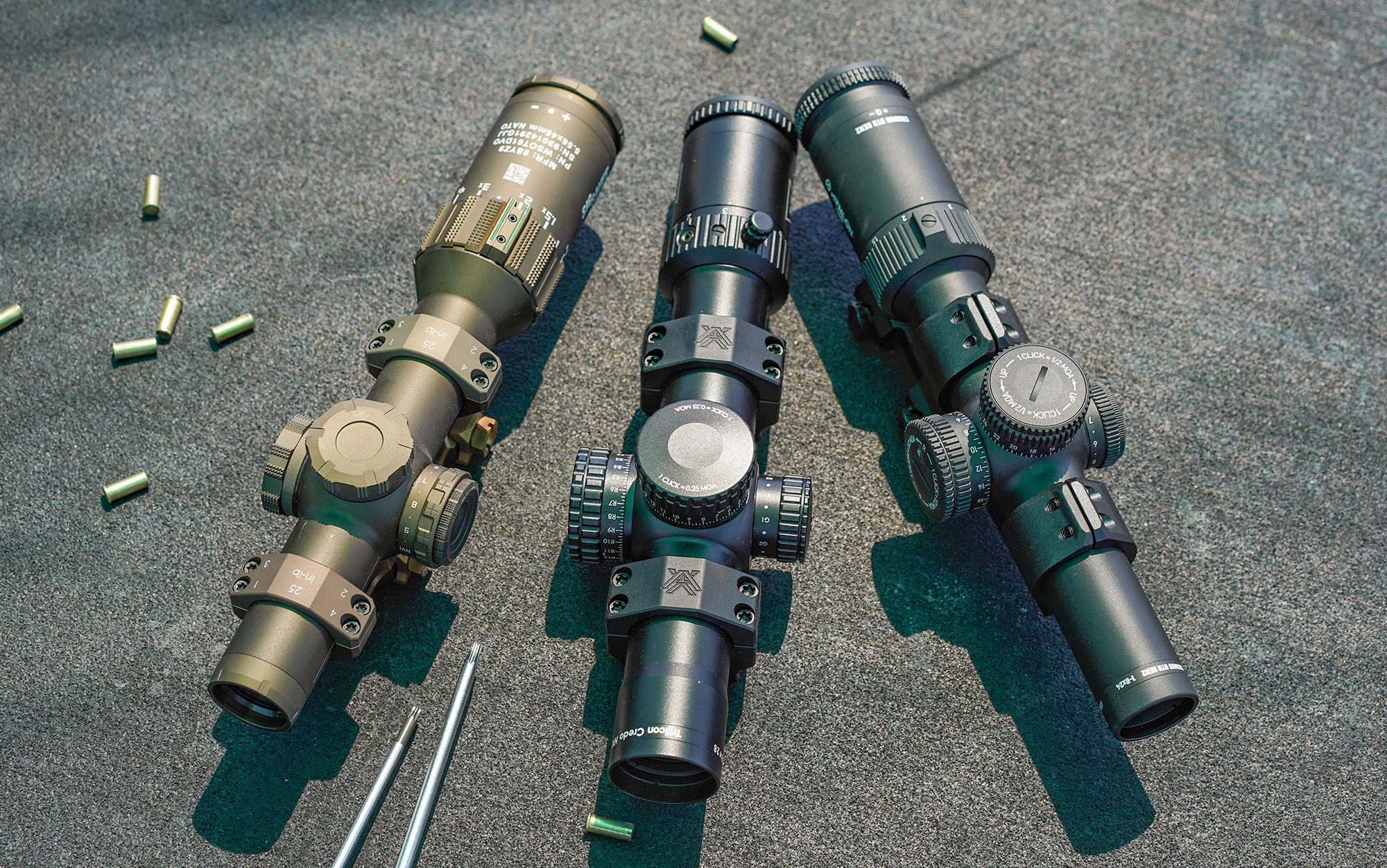
Because this is such a new and rising subset of sports optics, innovation defines the LPVO category. That dynamic alone makes this a buyers’ market. Do you want a do-it-all scope that can dominate a precision steel-target competition and then defend your homestead? Or do you want a simple, durable low-power scope that can toggle between your new 350 Legend lever gun and your turkey shotgun? This category has something for you.
Buyers are wise to look out for a few attributes. First, an unilluminated reticle on a 1-to-something-power scope is worthless. You need the aid of a bright, adjustable illuminated aiming point both in low-light conditions and in full sunlight. Second, you need a dual-purpose reticle. Here’s where the first-plane models have an advantage. They can transition from capable red-dot sights at the lowest magnifications to precision scopes at higher powers, boosting their value proposition in the process. That’s not to say second-plane reticles are useless. They are excellent choices for turkey and lever guns or for dangerous-game rifles where sure, swift, close-range shots are not only preferred, they may save your life.
One of the most surprising trends of modern sports optics is how expensive premium LPVOs have become. That may well be a function of the market; you buyers are willing to pay a kings’ ransom for these fairly niche optics. Look for the price to come down as more brands enter this space, delivering even more versatility and utility in configurations that put a premium on reticle design, illumination, and turret behavior than on glass quality.
Final Thoughts on the Best LPVO
More than any other category of rifle scope, the LPVO class has the widest variability of price and attributes. Want to spend just over $100 on a scope? There’s a model for you. Have a cool $2,000 to throw toward a short-range rifle scope? There are a couple options.
Given the variation within the category, it’s important to return to the value propositions of the configuration. LPVOs were initially AR-platform scopes, low-power workhorses that could engage targets up close and sometimes in dark conditions but they could also place bullets with decent precision at middle distances. That remains an important use-case for the platform.
But even more important is the scope’s “shootability.” That’s a squishy term, but it’s a combination of a number of attributes that combine to make an LPVO feel like an extension of your eyesight, or an organic part of your rifle. At low magnifications, can you engage targets quickly and with both eyes open for better situational awareness? Does the reticle and illumination guide your eye to the target, or are you fighting eye relief and reticle fuzziness and poor ergonomics?
“Shootability” extends to slow-fire situations, too. How clear is the glass and how visible are reticle references for precision bullet placement at ranges well beyond your zero-distance?
While we’re talking ideal LPVOs, we’d like to see capped turrets and a throw lever. And we don’t need manual parallax in this class; fixed 100-yard parallax is just fine.
When you’re in the market for your next LPVO, consider our wish list, plus good glass, liberal mounting dimensions, and a rock-solid warranty. If you use the scope the way it was designed, you might well need that warranty before your time with the scope is over.
Read the full article here

